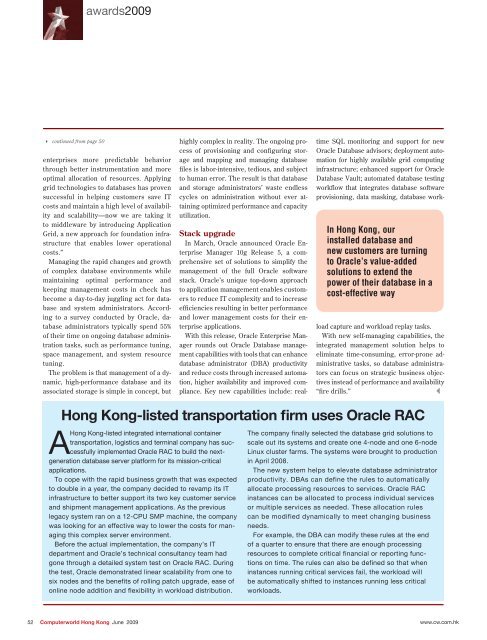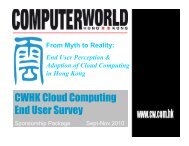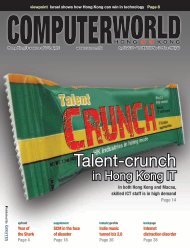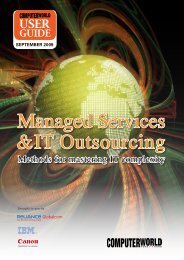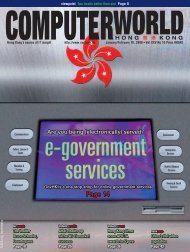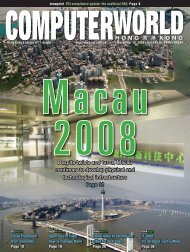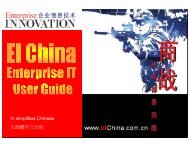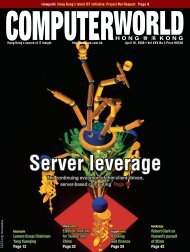Download - enterpriseinnovation.net
Download - enterpriseinnovation.net
Download - enterpriseinnovation.net
- No tags were found...
You also want an ePaper? Increase the reach of your titles
YUMPU automatically turns print PDFs into web optimized ePapers that Google loves.
awards2009 continued from page 50enterprises more predictable behaviorthrough better instrumentation and moreoptimal allocation of resources. Applyinggrid technologies to databases has provensuccessful in helping customers save ITcosts and maintain a high level of availabilityand scalability—now we are taking itto middleware by introducing ApplicationGrid, a new approach for foundation infrastructurethat enables lower operationalcosts.”Managing the rapid changes and growthof complex database environments whilemaintaining optimal performance andkeeping management costs in check hasbecome a day-to-day juggling act for databaseand system administrators. Accordingto a survey conducted by Oracle, databaseadministrators typically spend 55%of their time on ongoing database administrationtasks, such as performance tuning,space management, and system resourcetuning.The problem is that management of a dynamic,high-performance database and itsassociated storage is simple in concept, buthighly complex in reality. The ongoing processof provisioning and configuring storageand mapping and managing databasefiles is labor-intensive, tedious, and subjectto human error. The result is that databaseand storage administrators’ waste endlesscycles on administration without ever attainingoptimized performance and capacityutilization.Stack upgradeIn March, Oracle announced Oracle EnterpriseManager 10g Release 5, a comprehensiveset of solutions to simplify themanagement of the full Oracle softwarestack. Oracle’s unique top-down approachto application management enables customersto reduce IT complexity and to increaseefficiencies resulting in better performanceand lower management costs for their enterpriseapplications.With this release, Oracle Enterprise Managerrounds out Oracle Database managementcapabilities with tools that can enhancedatabase administrator (DBA) productivityand reduce costs through increased automation,higher availability and improved compliance.Key new capabilities include: real-In Hong Kong, ourinstalled database andnew customers are turningto Oracle’s value-addedsolutions to extend thepower of their database in acost-effective waytime SQL monitoring and support for newOracle Database advisors; deployment automationfor highly available grid computinginfrastructure; enhanced support for OracleDatabase Vault; automated database testingworkflow that integrates database softwareprovisioning, data masking, database workloadcapture and workload replay tasks.With new self-managing capabilities, theintegrated management solution helps toeliminate time-consuming, error-prone administrativetasks, so database administratorscan focus on strategic business objectivesinstead of performance and availability“fire drills.”AHong Kong-listed integrated international containertransportation, logistics and terminal company has successfullyimplemented Oracle RAC to build the nextgenerationdatabase server platform for its mission-criticalapplications.To cope with the rapid business growth that was expectedto double in a year, the company decided to revamp its ITinfrastructure to better support its two key customer serviceand shipment management applications. As the previouslegacy system ran on a 12-CPU SMP machine, the companywas looking for an effective way to lower the costs for managingthis complex server environment.Before the actual implementation, the company’s ITdepartment and Oracle’s technical consultancy team hadgone through a detailed system test on Oracle RAC. Duringthe test, Oracle demonstrated linear scalability from one tosix nodes and the benefits of rolling patch upgrade, ease ofonline node addition and flexibility in workload distribution.The company finally selected the database grid solutions toscale out its systems and create one 4-node and one 6-nodeLinux cluster farms. The systems were brought to productionin April 2008.The new system helps to elevate database administratorproductivity. DBAs can define the rules to automaticallyallocate processing resources to services. Oracle RACinstances can be allocated to process individual servicesor multiple services as needed. These allocation rulescan be modified dynamically to meet changing businessneeds.For example, the DBA can modify these rules at the endof a quarter to ensure that there are enough processingresources to complete critical financial or reporting functionson time. The rules can also be defined so that wheninstances running critical services fail, the workload willbe automatically shifted to instances running less criticalworkloads.52 Computerworld Hong Kong June 2009 www.cw.com.hk


